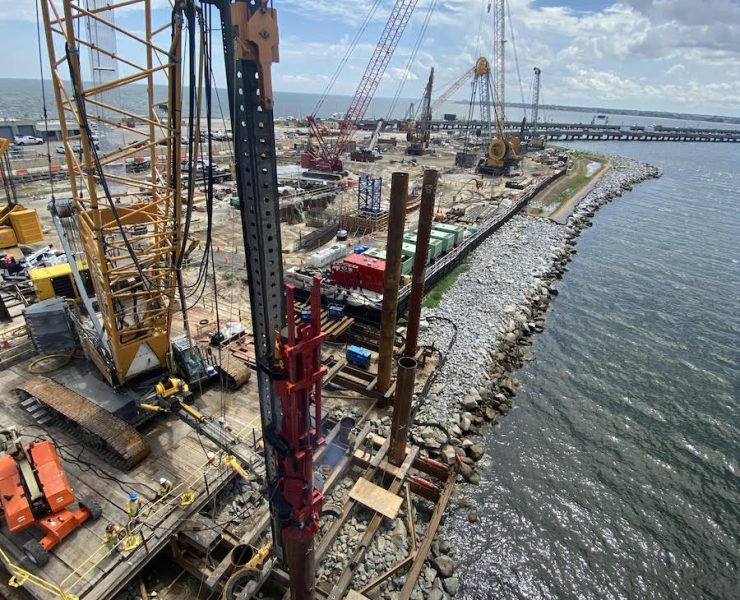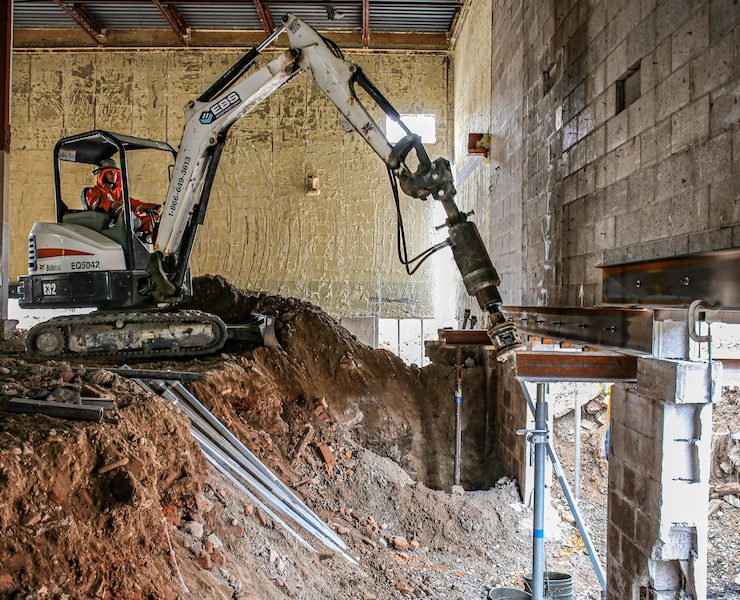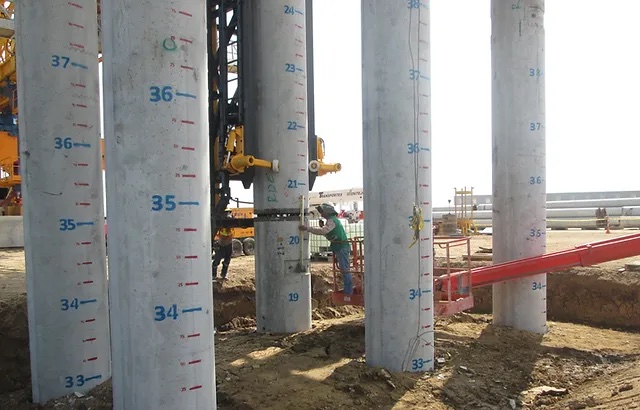Pile Driving Safety & Accident Prevention – Gear, Site Conditions, Material Storage/Handling, and More
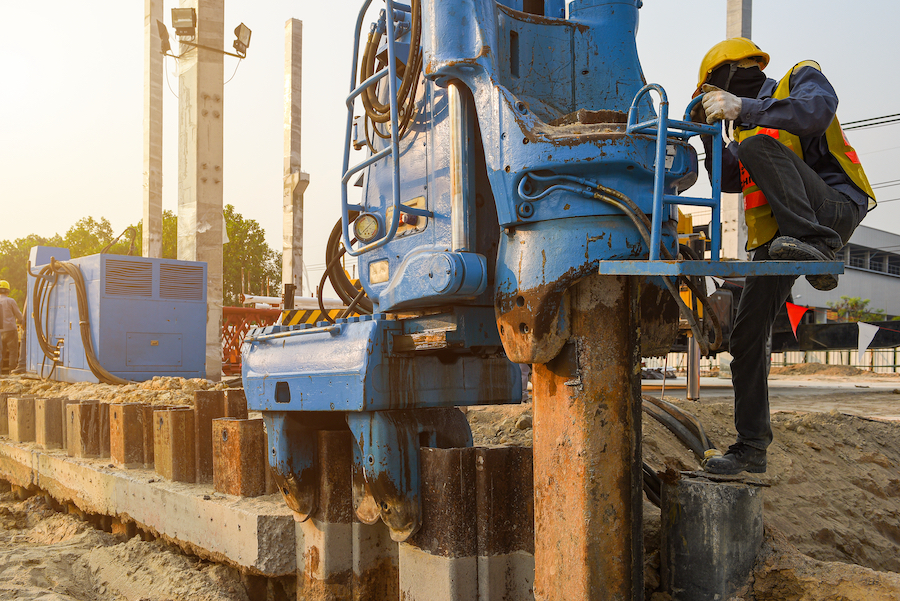

View the complete article here
The finalization of pre-construction planning and the commencement of pile operations is a welcoming but concerning time for contractors, as the tasks conducted in the coming weeks will present a host of potentially hazardous situations.
The dangerous conditions associated with pile operations elevate the importance of proper safety and accident prevention throughout the job, with a contractor placing equal focus on workers, equipment, supports, and specific tasks.
Starting a Project
At the onset of a job, a superintendent should conduct a meeting wherein safety rules are explained to all employees, with copies of the rules handed out.
Prior to this meeting, the superintendent should obtain telephone numbers of those to be contacted in emergencies, check that a fully stocked first-aid kit is onsite, and assure that a trained first-aid person or hospital is nearby in case of an emergency.
Additionally, a superintendent should review a project’s operating plan, equipment-related safety information, and OSHA recordkeeping requirements. Checking all onsite safety equipment and placing mandated safety posters on rigs and other appropriate places is also important.
Safety Gear
All operators and laborers must wear brimless plastic hard hats that conform to American National Standards Institute Z 90.1-1969, with spares available. These hats must be inspected before issuance, with any damaged hats discarded.
Burners cutting shells, light wall pipe, and light H-piles must wear either eyecup or cover spec-type welding goggles with shade 3 or 4 tinted lenses. When chipping or grinding, chipping goggles with clear lenses should be worn.
Welding helmets with a shade 10 or 12 lens, depending on the length of electrodes, must be worn by welders. If extensive welding operations are conducted, workers should be protected by portable shields and provided with shade 2 spectacles with side shields.
All workers handling plastic slate, creosoted piles, cement, and other irritating materials should wear neoprene-coated canvas work gloves.
When conducting marine operations, workers should be provided with life jackets, with a boat available during operations for potential rescues.
Within the onsite office, tool house, or change area, a multi-purpose dry chemical extinguisher, 6#, type 2A-10BC, should be provided. This type of extinguisher should also be present at the site of any welding or burning operations. Additionally, a dry chemical extinguisher, 2#, type 5BC, must be placed on each crane or other major piece of equipment.
Site Conditions
Work areas and walkways need to be kept free of loose materials, debris, pile cut-offs, and scrap lumber. Platforms and walkways more than four feet off the ground, or in a hazardous location, should feature a secure handrail with a toe board.
Properly built ladders must be maintained, with side rails extending 36” above a landing.
Containers for oil rags, combustible materials, and trash should be provided, with unused equipment stored outside of the working area.
When possible, drain any muddy area onsite and provide plank runways across trenches if necessary. Slippery walkways and other areas should be sanded. In freezing weather, salting is recommended.
Construction areas must be adequately lit if night work is to occur. Typically, temporary lights are installed, with power supplied by heavy-duty electric cords.
When working in areas containing harmful gases, vapors, fumes, or inadequate ventilation, suitable precautions must be taken. Additionally, special care must be taken when working in potentially flammable environments.
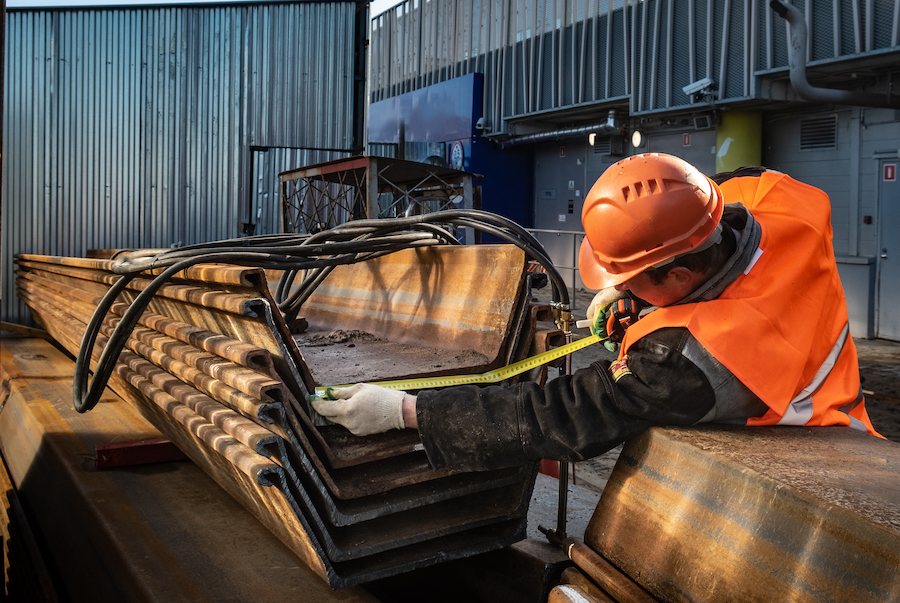
Material Storage
Stowed materials should be blocked, stacked, or secured in varying fashions to prevent sliding, falling, or collapse. If possible, stored materials should not be stacked higher than five feet. When storing materials on platforms or in buildings, do not exceed safe floor-loading specifications.
Shells should be stored using stakes or chocks, to prevent spreading, and placed away from the edge of any embankment.
Material Handling
When unloading shells and other pile material from a truck, make sure the load is safely held while stakes are removed. Following stake removal, load binders should be released from the backside of the load.
Handling large timbers, length woodpiles, and H-piles should be done via tongs when possible.
When handling materials, all workers should stand clear, with loads never being swung above the heads of those onsite. Tag lines should be utilized to control loads. No workers shall be permitted to ride on crane hooks, on top of loads, or in a truck’s cargo section.
Rope
Because ropes are easily cut or abraded, frequent inspection for wear and tear is necessary. A rope’s tail ends should never be cut off; rather, they should be tucked in beyond the splice.
During operations, workers should be advised to never stand alongside any rope under heavy strain, and especially nylon rope, which is stretchy and can be hazardous if a load is suddenly released.
Wire rope should be discarded when significant wear from outside wires, kinks, bird cages, corrosion, and crushing or heat damage is noted. A wire rope broken while in service should be replaced and never spliced.
Running ropes should be trashed when six randomly distributed broken wires or three broken wires in one strand can be found. Standing ropes must be replaced when more than one broken wire is present at an end connection, or when more than two broken wires are identified elsewhere.
Manila rope eye splices should have a minimum of three full tucks, with synthetic rope eye splices featuring four full tucks.
Slings
Loads should always be picked up with slings and never wrapped with a hoist line. Such slings must be inspected before each use, with workers discarding any sling featuring six or more closely spaced broken wires. Keep slings clean and lubricated to prevent rusting and to extend their useful life. When handling mats, utilize a two-leg sling.
Chains
All chains utilized should be of alloy steel grade, and paired with links, hooks, and rings to obtain full strength. As with ropes, chains should be inspected regularly and replaced when showing obvious wear. A wear of 1/8” at any point on a standard 5/8” pile chain is reason for disposal. All chains should be permanently affixed with a tag that states their size, grade, rated capacity, and manufacturer.
Hooks
Used only for temporary connections, hooks must be closely observed and never used for drills, jets, siphons, or other semi-permanent attachments. Instead, shackles are preferred in such cases.
Hooks should be turned so the pull of the line or chain is always into the hook. If a load could be momentarily slacked, a safety hook should be used. Any hooks showing cracks or signs of straightening must be disposed of.
Shoring
Shoring must be installed from the top down and removed in the opposite fashion. Hydraulic shoring should be inspected at least once per shift for leaking hoses or cylinders, broken connections, cracked nipples, bent bases, or any additional damage.
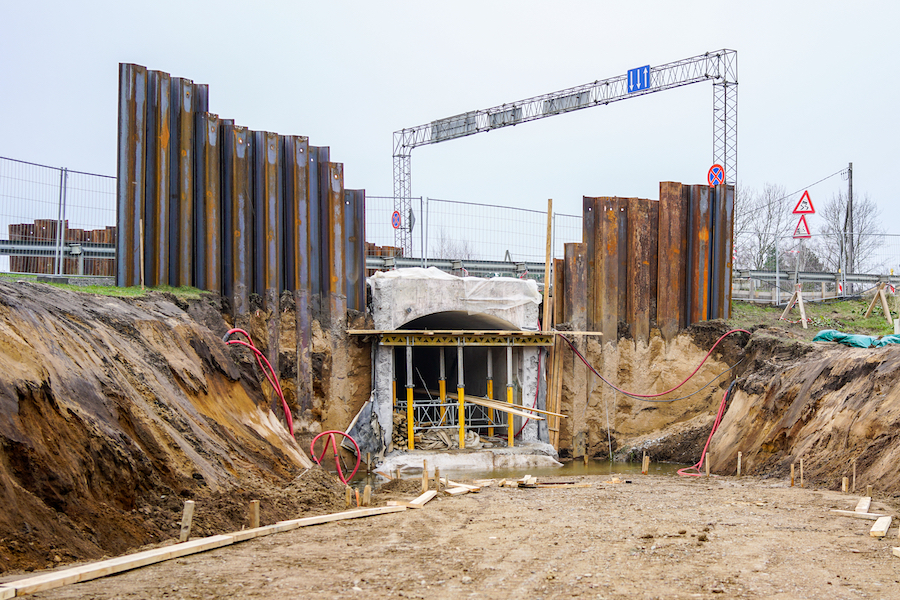
Trenches
When working in trenches 3 feet deep or more, an adequate exit ladder should be provided within 25 feet of any worker. Braces should be toe nailed to prevent slippage.
Excavation
Prior to excavating, identify what underground utilities are present by consulting plans, locating manholes and valve boxes, and reviewing utility maps. If excavating near structures, sheeting should be tight and advanced ahead of excavation when necessary.
Underpinning a foundation should be conducted only under the direction of a registered professional engineer.
Earth excavation to a depth of 2 ft. (0.61 m.) below the shield is permitted, but only if the shield is designed to resist the forces calculated for the full depth of the trench and there are no indications (while the trench is open) of a possible loss of soil from behind or below the bottom of the support system.
When conducting permitted earth excavations two feet below a shield, constantly observe the effects of bulging, heaving, boiling, and vibration below the bottom of the shield.
Spoil
Avoid placing a temporary spoil closer than two feet from the surface edge of excavation. Doing so ensures that loose rock or soil will not fall on employees working in the trench.
Permanent spoils should be placed some distance from an excavation, as improper placement can cause an excavation operation to be non-compliant with specific horizontal-to-vertical ratio requirements.
Pile Driver Assembly
Prior to unloading the rig, a superintendent must insure that adequate handling equipment is available, with slings and other rigging in good working condition. A firm, level site which is free of overhead power lines is optimal for rig erection.
All equipment that arrives and is unloaded should be inspected for cracks, signs of overstressing, and deterioration that could limit functionality. All wire rope, including hoisting lines, pendants, and slings, should also be inspected, along with headblocks, fairleaders, and other fittings.
While workers are bolting up leaders, the rig operator should conduct a detailed inspection of the crane or hoist. All controls should operate properly, with the operator adjusting clutches and brakes, checking the operation of swing and travel locks, and inspecting drum ratchets and pawls.
When lifting equipment, ensure adequate size slings are utilized and properly tied down to the transport in order to prevent shifting. Additionally, use tag lines to prevent loads from uncontrollably swinging, and provide blocking to allow loads to land safely.
Erection
Before raising leaders, a superintendent and operator should ensure that:
- Adequate tag lines are provided
- No tools or extra bolts have been left on the boom or leaders
- Hammer extensions and sliding frames are cabled securely
- Steam, jet, and hydraulic hoses have been inspected; if connected to the boom tip, these hoses must have safety chains secured to the boom
- All joints are safely tied down
- Lower hose ends and boom safety cables are wired to the boom
- The leaders’ center of gravity are below the boom point
- The weight of the leaders, extensions, and drill guides are within the safety capacity of the crane
When erecting, do not attempt to add additional counterweight or tie down the back of the crane. Doing so can cause gantry and topping lift failure.
When raising commences, pay close attention to rear track rollers, watching the mat and ground under the front ends of the crawlers.
After raising the leaders, attach the sliding frame to the spotter and connect the boom safety cables. Once the hammer is lifted, lower its extensions and cable them off. As hoses are attached, ensure safety chains are secured.
Moving the Rig
Operating over unstable ground represents the most hazardous aspect of moving the rig. As a rule, avoid moving a rig over areas where the ground is soft or uncompacted. Areas above old sewers or underground structures that will not support the rig, or areas adjacent to excavations, should also be avoided when possible. If crossing over an old sewer or freshly backfilled trench, double matting represents the simplest precaution.
Working near the edge of an excavation is typically avoided, as the edge of cats should be kept at least two feet back from the toe of excavation for each foot of height. When working near the edge of an excavation is necessary, the slope should be sheeted and braced, or the mats supported by stacks of mats, cribbing, posts, or false-work piles.
If operating the rig above a deep excavation, cribbing may be utilized for support. These cribs should be founded on planking. If the excavation is six or more feet deep, a steel beam trestle should span the hole rather than one of plank wood. The rig can also be mounted on a gantry.
Clearing overhead obstacles is vital to rig movement, with leaders not to come within 20 feet horizontally or 10 feet vertically of high-tension lines. When overhead obstructions can’t be avoided, the rig may be dismantled.
If a rig travels on ramps, significant coordination between the supervisor and operator is necessary, as this operation is fundamentally hazardous.
Before entering on a ramp, locks should be checked, and with the operator prepared to engage them quickly. The travel lock should be in ratchet position when going uphill, with the leaders facing uphill and the boom down if necessary. Additionally, the operator should hold the hammer on the brake so that it can be lowered to the ground to serve as an anchor.
If it is necessary to drive piles from a ramp, wedges can be cut from heavy timbers to fit under each track. This will temporarily level the rig for driving.
When moving the rig around the site, the supervisor should position himself in the operator’s view while also being able to view the operating areas to the rear and sides.
Only the supervisor, or a trained signalman, should sign to the operator, with standard hand signals being utilized. Additionally, the supervisor should ensure that all workers are clear before giving a signal to move, swing, pick up, or lower a load. The hoisting or swinging of loads over areas where typical work operations are conducted should be avoided.
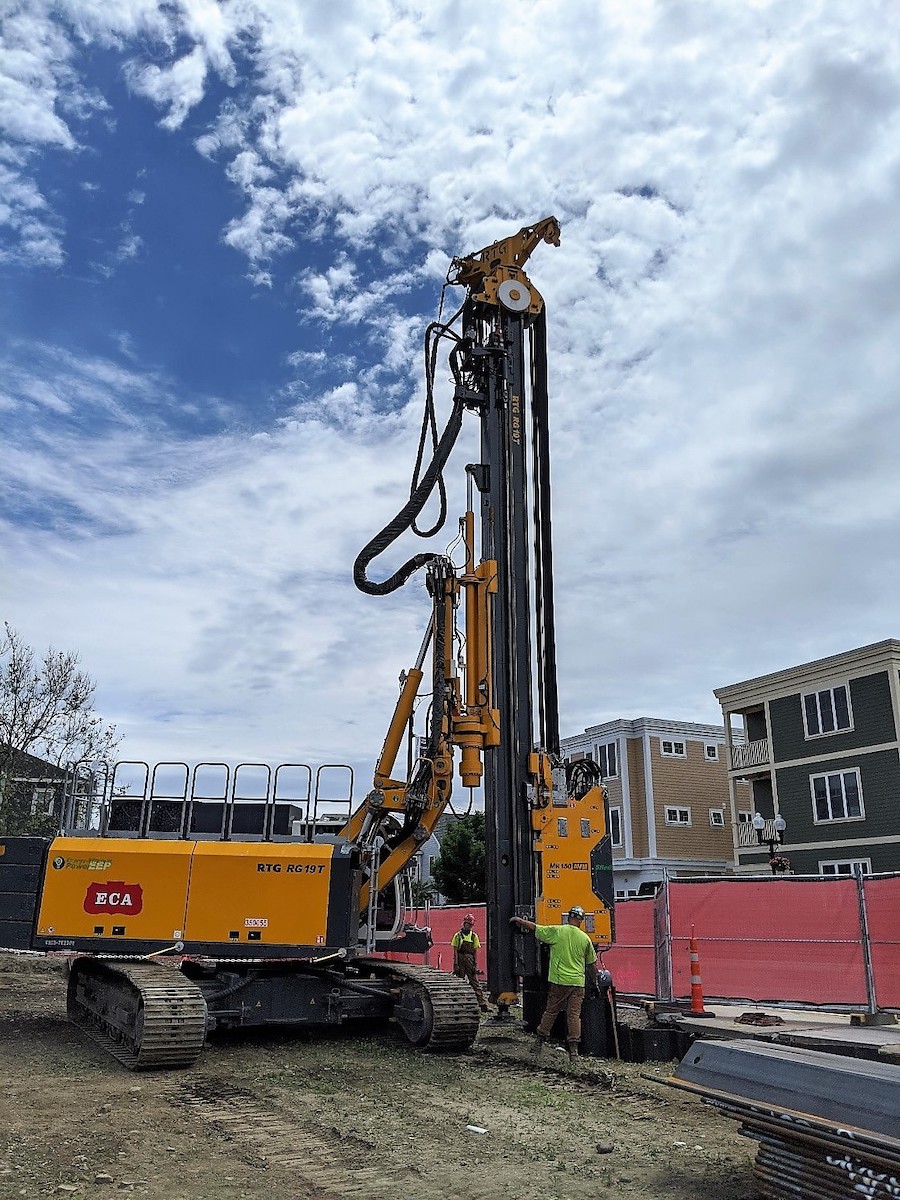
Driving Piles
Pile driving is complicated, yet common sense and general safety rules – combined with a knowledge of pile-related problems – can equate to safe working conditions during operations. Safety rules to adhere to include:
- Lift piles with proper slings or other equipment, with workers properly trained in their use
- Pick up piles from the side opposite of other operations
- Clear workers when piles are hoisted into the leads
- Do not undermine the rig or an adjacent structure when jetting or pre-excavating for piles
- Clean augers of clods of earth and rocks as they are hoisted out of the ground
- Holes made in advance should then be covered or barricaded to prevent a possible fall
- Instruct workers to never be under the hammer or core at any time
- Release the core sling on both sides when changing capblocks or a hammer cushion
- Keep workers away from leads when capblocks or a hammer cushion is being changed
- Keep the hammer under control during driving, via slight pressure on the hammer drum brake
- Shut off the hammer immediately if the pile should break or start running into the ground
- Watch the hammer hose closely when lifting the hammer at the end of driving, ensuring it does not catch
- Hold any hose loop below the leaders away from them until the hose is clear
Concreting
Pile driving and concrete operations should be coordinated so that piles are not dragged and the rig is not swung over an area of concreting in progress.
The principal cause of concreting accidents is associated with the use of narrow or unstable runways. When runways are more than three feet above ground, duckboards should be used. Because cement can be irritating to the skin, workers should be fitted with rubber-coated gloves.
Welding and Cutting
Essential aspects of pile driving operations, welding and cutting can be conducted safely via several precautions.
General welding and cutting recommendations include:
- Don’t permit anyone to strike an arc on a compressed gas cylinder
- Don’t weld near flammable or combustible materials
- Avoid welding on containers that have held combustible or flammable materials
- Avoid welding in confined spaces without adequate ventilation
- Hot objects should not be picked up
- Delay chipping or grinding without suitable goggles
- Don’t move individual cylinders without a cap over the valve
- Avoid dropping or abusing cylinders
- Confirm cylinders are well fastened in their stations
- Avoid using a hammer or wrench to open cylinder valves
- Never interfere with fuse plugs
- Protect the hose from being trampled on
- Avoid tangles and kinks
- Don’t leave the hose unattended, as it could turn into a tripping hazard
- Protect the hose from sparks, hot slag, hot objects, and open flames
- Don’t allow the hose to come in contact with oil or grease
- Ensure that connections between the regulators, adaptors, and cylinder valves are tight
- Determine if acetylene is escaping by smelling for odor. Additionally, test with soapy water, but never with an open flame
- Avoid using matches for lighting torches, and instead use friction lighters, stationary pilot flames, or other suitable sources of ignition
- Don’t hang a torch with its hose on regulators or cylinder valves
- Don’t cut material that would permit sparks, hot metal, or severed sections
- When welding or cutting is stopped temporarily, release the pressure adjusting the screws of the regulators – turning them to the left
- If welding or cutting operations are stopped for a lengthier time, close the cylinder valve and release all gas pressure from the regulators by opening torch valves momentarily
- When equipment is taken down, make certain all gas pressure is released from the regulators, with the pressure adjusting screws turned to the left
Cutting Off Pipe Piles
When piles are cut nearly flush with the ground, the heads should be covered to keep foreign material out and to prevent someone from stepping into the pile.
When flammable gases are encountered, drop a piece of lighted oil-soaked rag into the pile before cutting with a torch – keeping head and body away from the head of the pile.
Short, cut-off pieces should be stored with the hot end down. Workers handling these cut-offs should always wear gloves. Workers cutting creosoted piles should wear clear goggles and rubber gloves.
When dewatering piles with a steam siphon, hoses must be in good condition and unobstructed with their fittings tight. A quick-opening valve should be provided to operate the siphon, with a worker staying at the valve. Once the steam is turned on, steam or water should come out of the discharge line. If the discharge line is plugged, steam will mix with water and blow into the pile.
Caissons
Caissons should be covered when not being worked on. The head of the casing should extend at least 8 inches above ground level, which will prevent anything from being kicked into the hole.
Electrical
Like other equipment, electrical tools should be inspected regularly for defective or frayed cables. Points where cables enter tool housings and switch boxes should particularly be checked and repaired immediately. Under no circumstances should a defective device be utilized by substituting a larger fuse or bypassing the overcurrent device.
Marine Work
All marine equipment must meet U.S. Coast Guard or equivalent regulations, with no work conducted in a navigable waterway until a permit has been secured from the U.S. Army Corps of Engineers or an equivalent party.
Barges and boats should be equipped with Coast Guard approved lights, bells, whistles, life preservers, ring buoys, and fire extinguishers. Additionally, vessels and equipment must be securely moored to prevent drifting.
Ladders extending from decks of barges and other work surfaces to the water, along with a skiff, should also be provided.
Suitable access ramps and gangways for equipment and people shall be provided between barges and docks or other barges.
Inspections
Both daily and monthly inspections are required of the superintendent and supervisors, who should be assisted by experienced workers. All work areas and equipment should be analyzed, this including rig controls.
Every time a rig’s engine is shut down, the operator should check the gauges and listen for any abnormal air leaks. The operator should also observe the steam piping and boiler for signs of leakage, checking that the safety valve is unobstructed and that the boiler is in safe operating condition.
Once a month, the superintendent should check that:
- OSHA notice and safety posters are displayed
- OSHA records are up to date
- Materials are stored safely
- General project housekeeping is acceptable
- Fire extinguishers are in their proper places and in usable condition
- First-aid kits are properly equipped and available
- Work habits conform with good safety practices
- Foremen are properly instructing workers in safe working conditions
A report detailing the above monthly inspection should be crafted, noting any defects and suggesting the corrective action to be taken.
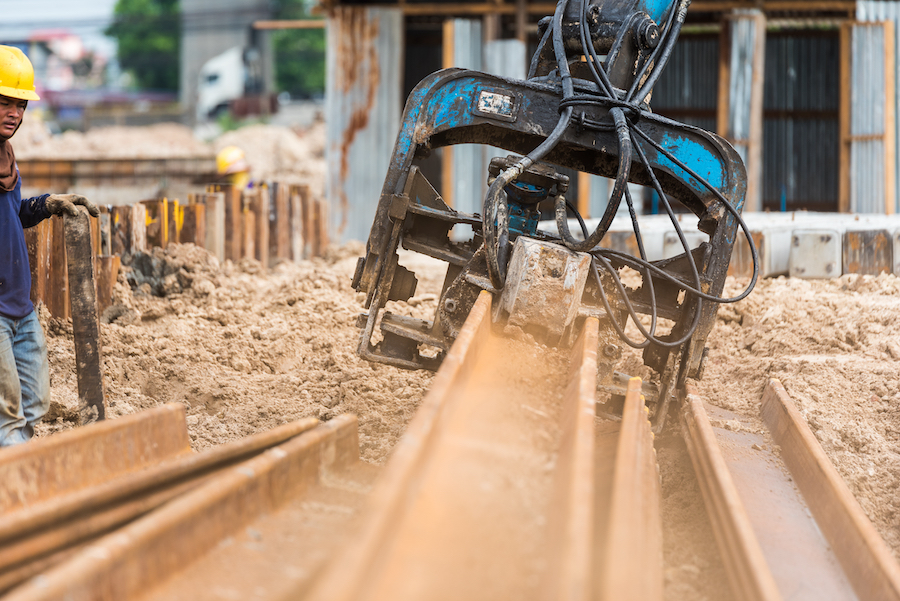
Reporting Accidents
All accidents should be reported by workers, no matter the perceived insignificance, as prompt reporting can prevent a minor accident from developing into a serious situation.
The superintendent must craft a written report anytime an accident causes an employee to require medical attention. Report any instance where a worker seeks medical help for falls or strains that involve back or internal injuries, no matter how slight. The original report should be submitted to the contractor’s nearest insurance carrier office.
If a serious or fatal accident occurs, an immediate report should be made via telephone, this to be followed by a written report. A fatality or accident that results in the hospitalization of five or more employees must be reported within 48 hours to the nearest regional OSHA office.
The superintendent must maintain a log of all reportable accidents and injuries on OSHA Form 100. This log should be kept up to date and made available for examination by any federal or state representative, or in the case of an OSHA inspection. Following project completion, this log should be included with other project records and sent to a district or regional records center.
Loss or Damage of Company Equipment
A superintendent must notify his general superintendent of any loss or damage of company-owned equipment when that damage or loss exceeds $100. A brief report should be included which details the equipment, the manufacturer’s serial number, the extent of the damage or loss, and the circumstances surrounding the incident.
If a major piece of equipment is involved or if the loss exceeds $10,000, the report to the general superintendent should be made via telephone or email, with a written report to follow. Any equipment believed to have been stolen should also be reported to local police.
Moving forward, pile driving operations will continue to present contractors and workers with a host of potentially hazardous situations and environments, further stressing the importance of safety and accident prevention knowledge on the part of all those involved on a project. For superintendents, this in-depth knowledge represents an invaluable tool that will heighten the efficiency, safety, and overall result of upcoming jobs, while also keeping employees safe and keeping projects on budget.
View the complete article here
Can you work near the edge of an excavation?
Working near the edge of an excavation is typically avoided, as the edge of cats should be kept at least two feet back from the toe of excavation for each foot of height. When working near the edge of an excavation is necessary, the slope should be sheeted and braced, or the mats supported by stacks of mats, cribbing, posts, or false-work piles.
When do you need to report an accident to OSHA office?
A fatality or accident that results in the hospitalization of five or more employees must be reported within 48 hours to the nearest regional OSHA office.














